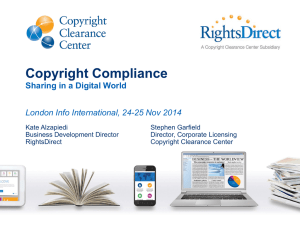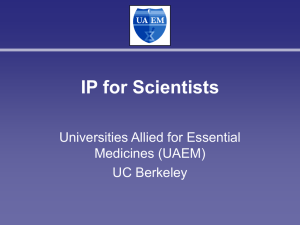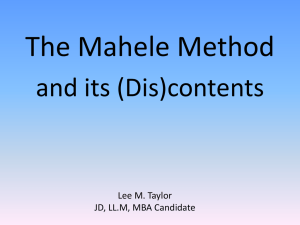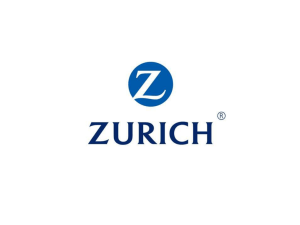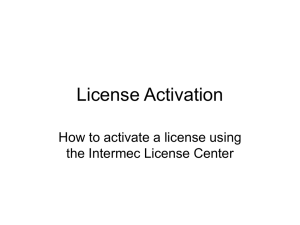Software Licenses - The Texas A&M University System
advertisement
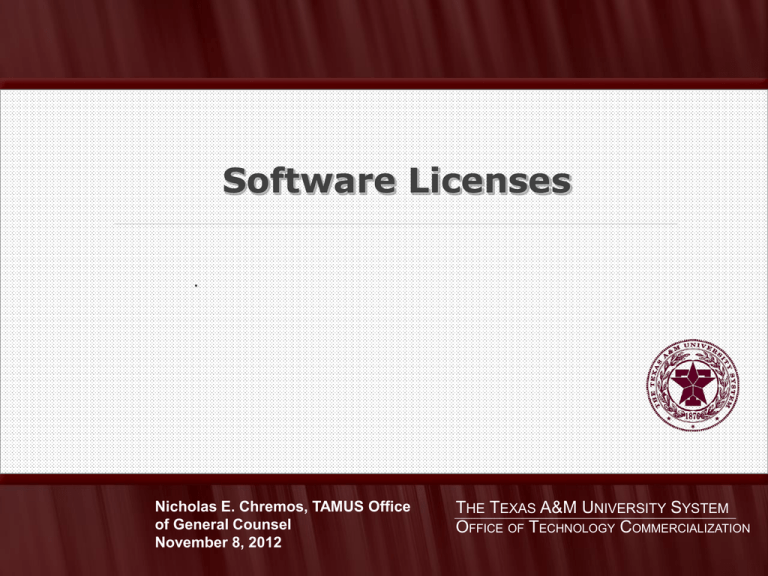
Software Licenses . Nicholas E. Chremos, TAMUS Office of General Counsel November 8, 2012 THE TEXAS A&M UNIVERSITY SYSTEM OFFICE OF TECHNOLOGY COMMERCIALIZATION Overview • What is a software license? • Software’s components • What to look for in reviewing software license agreements? – Off the shelf-mass market software – Somewhat customizable software – Customized software • Licensing member-owned software What is a License? A contract whereby the software owner conveys certain intellectual property rights, assigns certain obligations, assumes certain obligations, and imposes certain risks on a licensee. Software Components: Software, Service, etc. • The software itself – Source code • Human readable • Never provided in off-the-shelf software – Object code • Machine readable • Always provided in off-the-shelf software • Service and support • User manual Software Components: intellectual property • Intellectual property rights associated with the software – Copyrights • In the software context, these protect: – The source code as written (totally irrelevant in off-theshelf software; somewhat relevant in other contexts) – The user interface if it has some originality » Example: The arrangement and choice of icons on a desktop is copyright-protected. Software Components: intellectual property – Trademarks – Utility Patents • Cover some features of software, nearly always features of which the user is unaware. – Design Patents • In the software context, these, like copyrights, protect the icons on a screen. – Example: (U.S. D 604,305 S) Spectrum of Issues Few issues-------------------------Many issues Mass Market Custom Designed Software Software Mass Market Software Mass Market Software • Mass market software licenses are not negotiable, so don’t waste time trying to negotiate boilerplate. • Focus on the software vendor’s existing options regarding service and make sure that you purchase the option that is optimal for your organization’s needs. • Make sure that you purchase a license that optimizes your organization’s needs for the number of simultaneous users who can use the software. Somewhat Customizable, Off-the-Shelf Software More issues involved in buying somewhat customizable software • Service – Review the license agreement’s terms and conditions of service and support. Make sure that these are consistent with your organization’s needs. • Updates – Ensure that new updates are included as part of the license. New versions, however, won’t be a part of the license. More issues involved in buying somewhat customizable software • Special features – If you are purchasing software that requires special features, ensure that the license’s terms and conditions obligate the supplier to implement those features by a specified date. – Ensure that the license specifies with particularity the specifications of the special features to be included. More issues involved in buying somewhat customizable software • Performance Specifications – The license should include performance specifications, such as: • Errors – timeframe for correction. E.g. Within 24 hours of detection. • Downtime – how often, how much. More issues involved in buying somewhat customizable software • Consequences for failure to meet specs: – Ensure that the contract specifies what happens if the software doesn’t meet the specs set forth in the contract. – After a certain number of repeated failures, the contract should be terminable for cause. More issues involved in buying somewhat customizable software • Use and users – Many licenses specify how many users can use the software simultaneously. Ensure that the number of simultaneous users is sufficient for your organization’s needs. Custom Designed Software Custom Designed Software • These license agreements must be drafted-i.e.-boilerplate doesn’t suffice. • To draft an adequate agreement, must understand the software’s technical requirements and end-user requirements. • These requirements drive all aspects of the license agreement. Custom Designed Software • Issue 1: Software Function – Ensure that the contract (usually in the statement of work) details the following with particularity: • What the software is intended to do. – Include detailed performance specifications • What constitutes completion of a task such that the supplier will get paid after its completion. • Include detailed operating parameters and specifications. Custom Designed Software • Issue 2: Software Support – Will the supplier be contractually obligated to provide support? – If so, then: • How much? • For what? • What turn-around time is acceptable? Custom Designed Software • Issue 2: Intellectual Property – Which party owns the intellectual property? • The supplier will own the copyrights, patents, and any other intellectual property associated with the software development unless the contract specifies otherwise. Custom Designed Software • Issue 3: If the supplier owns the intellectual property associated with the software, what can your organization do with the software? – At a minimum, must include use rights. – Should probably include the right to make an archival copy. – Should probably permit the display of results involving the software’s use. – Determine whether your organization needs the right to make derivative works based on the software and what your organization can do with these derivative works. Custom Designed Software • Issue 4: Warranties – If you fail to include an express warranty and the software fails after you have accepted it, then your ability to obtain redress is limited. – If the contract includes express warranties, then must detail: • Timeframe during which the warranty is applicable. • What the warranty covers. • How to exercise the warranty rights. Custom Designed Software • Issue 5: Risk Shifting Provisions – If the software doesn’t work as specified in the contract and harms third parties which then sue the university or System component, how broad or narrow should the duties to defend and indemnify be? – If you ask for a duty of defense and indemnity and the supplier is small, ensure that the supplier has adequate insurance to be able to meet the defense and indemnity obligations. Licensing System or Member Owned Software System or Member Owned IP? Licensing System or Member Owned Software Is it system or member owned intellectual property? – System policy 17.01 says that it is System owned if it was created (a)as a result of an individual’s employment responsibilities, (b) with support from the system or any of its members in the form of administered funds, and/or (c) with significant use of resources. – It is member-owned if it was (a) created by an employee who was hired specifically to produce the intellectual property for institutional purposes or (b) commissioned by the member and assigned to the member in writing. Non-Exclusive or Exclusive License? Licensing System or Member Owned Software • There are two approaches: – Exclusive license: • The licensee can sue others for infringing the licensed copyrights and patents associated with the software and the institution is a nominal party in the litigation. • The licensee can infringe the intellectual property as specified in the license. Licensing System or Member Owned Software • There are two approaches: – Non-exclusive license: • The licensee can infringe the intellectual property as specified in the license. Licensing System or Member Owned Software • The extent of the rights conveyed will depend upon how the licensee expects to commercialize the intellectual property. – Example: Broad rights – “System hereby grants and Licensee now accepts a worldwide, non-transferable, royalty-bearing, and exclusive license under Patent Rights and Copyright Rights to use the Licensed Intellectual Property, to reproduce the Licensed Intellectual Property, to distribute the Licensed Intellectual Property, to import items covered by the Patent Rights and Copyright Rights, and to offer for sublicense and sublicense the rights granted hereunder.” Other Considerations: •Delivery of code. •Risk shifting provisions. Licensing System or Member Owned Software • Delivery of source code to licensee usually necessary. – To effectuate the rights granted under the license, the System or member usually must provide the licensee with the software’s source code but there are exceptions. Licensing System or Member Owned Software • Always disclaim warranties and make the licensee waive them. – All System/Member-developed software is experimental, and neither the System nor the Member want to extensively support the software. – Therefore, licensee takes the software “as is” and this is reflected in the royalty-rate and other fees payable to the licensor. Licensing System or Member Owned Software • Usually ask the licensee to provide broad defense and indemnification rights to the System/licensor for third party claims arising out of the licensed software. More information? Contact: Nick Chremos 979-458-2635 979-458-6134 nchremos@tamus.edu
